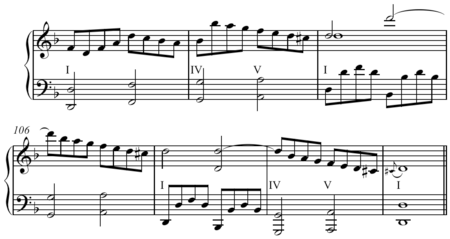I–IV–V–I
In music, I–IV–V–I or IV–V–I is a common chord progression and cadence that, "unequivocally defines the point of origin and the total system, the key."[1] Composers often begin pieces with this progression as an exposition of the tonality:[1]
A perfect authentic cadence in four-part harmony
According to theorist Oswald Jonas, "[a]long with motion toward the fifth (V), IV [the subdominant] appears as a corrective, depriving V (the dominant) of its independence and pointing it back in the direction of its origin [I]."[1] In the key of C, IV provides the note F♮ and eliminates the possibility of G major, which requires F♯.[1] The progression is also often used at the end of works and sections.[1]

I–IV–V–I chord progression in J.S. Bach's The Well-Tempered Clavier Book II, Prelude in C Major.[1] 
See also
- Predominant chord
- Three-chord song
- V–IV–I turnaround
- ii–V–I turnaround
- Ragtime progression
Sources
- Jonas, Oswald (1982). Introduction to the Theory of Heinrich Schenker (1934: Das Wesen des musikalischen Kunstwerks: Eine Einführung in Die Lehre Heinrich Schenkers), p.23. Trans. John Rothgeb. ISBN 0-582-28227-6.
This article is issued from Wikipedia. The text is licensed under Creative Commons - Attribution - Sharealike. Additional terms may apply for the media files.
